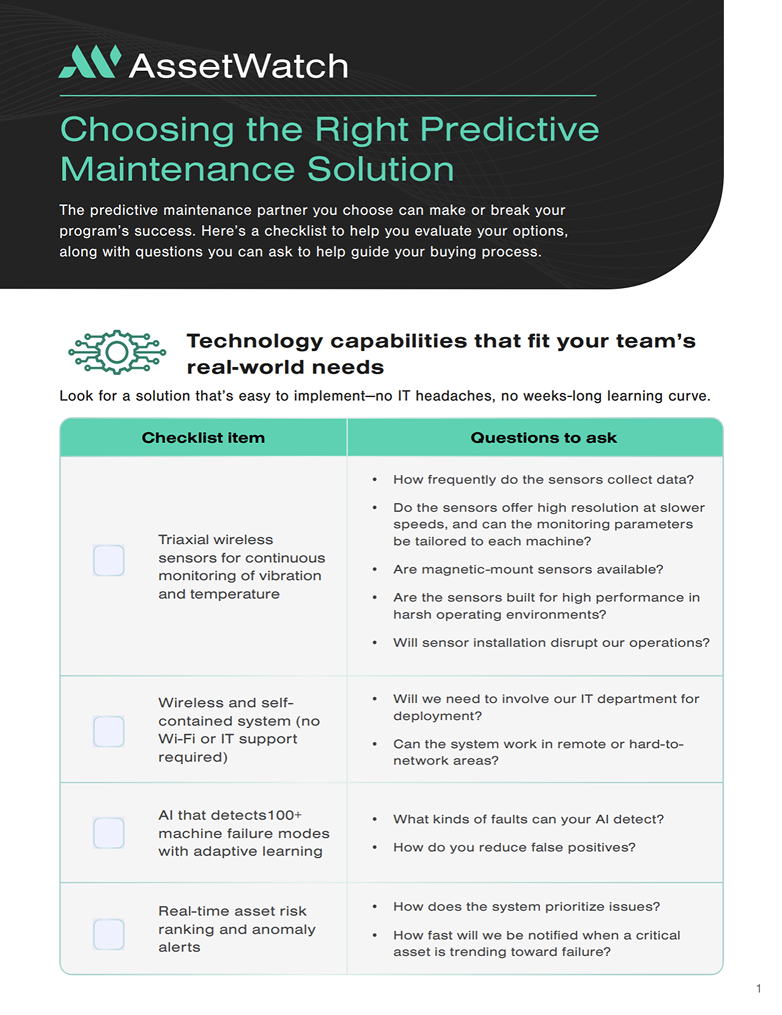Regardless of the industry you’re in, you no doubt rely heavily on machines that use rotating parts to perform their primary function. Ensuring the health and reliability of these assets—namely pumps, compressors, turbines, motors, fans, blowers, and gearboxes—is essential for keeping production lines up and running.
Apart from the chaos and high costs of sudden breakdowns, the downstream effects of equipment faults left unchecked can incur even more damage—from shorter equipment lifespan to increasing risk of failure across the board.
If you want to take charge of your production line, simplify maintenance, and slash unplanned downtime, the solutions are pretty straightforward. Below are the top 10 rotating equipment issues that plague manufacturers, along with steps you can take to mitigate these challenges.
10 Common Problems That Can Bring Production Lines to a Halt (and What to Do About It)
Each type of rotating equipment requires specific maintenance and operating practices to optimize both efficiency and output. To ensure you’re getting the highest possible value out of every asset, you might also need greater visibility and insights than you have today. This list can help you get started on the road to optimal equipment health.
1. Poor Maintenance Practices
No matter how new or robust your rotating assets, premature failure will happen if you don’t maintain them.
The Fix: It’s important to conduct regular inspections, ensure appropriate and adequate lubrication, and perform timely maintenance tasks. Predictive maintenance enabled by condition monitoring (vibration, oil, temperature) can empower your team to eliminate unplanned downtime for good.
2. Misalignment
Equipment misalignment is a frequent problem that can result in excessive vibration, bearing wear, shaft damage, and equipment failure.
The Fix: By monitoring harmonics via vibration sensors, you can catch misalignment early and prevent further damage.
3. Incorrect Installation
Your asset may be brand new, but it’s not immune from sudden failure. Missteps during installation such as over-tightening belts, incorrect mounting, and unbalanced rotors can cause severe equipment issues.
The Fix: Ensure technicians are properly trained and provide clear documentation to ensure installation is done correctly.
4. Inadequate lubrication
Inappropriate, inadequate, or excessive lubrication in rotating equipment like gears and reciprocating compressors is the hidden enemy that puts numerous production lines at risk. Lubrication missteps or neglect can lead to significant wear and tear and equipment failure.
The Fix: It's crucial to use the correct type of lubricant in the right quantity and at appropriate intervals. With regular training on lubrication practices and a robust oil analysis program, you can prevent catastrophic failures with ample lead time to schedule maintenance tasks.
5. Vibration Issues
Excessive vibration can easily go undetected until it’s too late. Along the way, it can cause considerable damage by way of bearing failures, structural damage, and sudden machinery failure.
The Fix: Implementing vibration monitoring and analysis tools can help identify these issues early and allow maintenance teams to respond in a timely way. Pairing vibration and oil analysis will allow you to catch issues far earlier, saving wear and tear on your equipment and increasing maintenance efficiency.
6. Operational Overload
Operating equipment beyond its designed capacity can cause undue wear and tear, overheating, and premature failure.
The Fix: Always adhere to manufacturer specifications and operational limits to avoid overloading.
7. Temperature Fluctuations
Extreme temperature changes can cause components to expand and contract, leading to misalignment, wear, and failure. They can signal other equipment issues as well.
The Fix: Monitoring and maintaining proper operating temperatures can help you avoid a wide range of problems. Triaxial sensors that track vibration and temperature, with AI and human analysis of the data, can provide a holistic view of asset health.
8. Contamination
Dust, dirt, and other contaminants can significantly affect the performance of rotating equipment, leading to issues like bearing failure or lubrication problems.
The Fix: Implementing contamination control strategies can help prolong your equipment's lifespan.
9. Component Wear and Tear
Regular use of equipment leads to inevitable wear and tear on components. This one can’t be avoided, but it can be effectively addressed.
The Fix: You can minimize the operational effects of wear and tear with regular inspections, timely replacement of worn-out parts, and use of high-quality components.
10. Inadequate Training
What your team doesn’t know can hurt your operation. Improper equipment handling due to a lack of training can lead to many issues, from incorrect installation to poor maintenance.
The Fix: Ensuring every team member who handles the equipment is adequately trained is key to avoiding a slew of potential problems.
Take Charge and Transform Your Plant with Proactive Maintenance
While rotating equipment requires proactive care to operate at its peak, fixes for the most common (potentially catastrophic) equipment issues are fairly simple. Regular maintenance, continuous training, high-quality materials and seals, and advanced monitoring and analysis tools are key to managing risk across your production line and ensuring the longevity and efficiency of your rotating equipment.
Your data holds the key to managing the above challenges and racking up quantifiable cost savings. But how can you extract the most value? Check out the on-demand webinar “Unlocking the Value of Maintenance: The True Cost of Ignoring Your Lubrication and Vibration Data” to learn more.


















